The Best At-Home Chest Workouts (with Bodyweight, Dumbbells, or Bands!)
Many serious gymgoers think at-home chest workouts are a waste of time.
By their lights, no amount of push-ups, band presses, or bodyweight dips will compare to training with barbells, dumbbells, and machines.
What’s more, they say, even if they were effective, at-home workouts (chest or otherwise) would still get stale faster than a loaf of bread in a hobo’s backpack.
In reality, though, at-home chest workouts don’t have to be a fruitless grind.
Design them well, and you should be able to maintain—or perhaps even gain—muscle with bodyweight workouts alone. And if you get your paws on some bands or dumbbells, you’ll be able to retain much of your strength, too.
We’ll break it all down in this article. You’ll also get 12 weeks’ worth of free at-home chest workouts, all expertly laid out in Google sheets.
Let’s get started.
- The Anatomy of the Chest Muscles
- The Simple Science of Effective At-Home Chest Workouts
- 1. Do more reps or sets.
- 2. Use more challenging exercise variations.
- 3. Use bands or dumbbells.
- The Legion At-Home Chest Workouts
- The Legion Band At-Home Chest Workouts
- The Legion Dumbbell/Kettlebell At-Home Chest Workouts
- 3 Tips for Better At-Home Chest Workouts
- 1. Do two chest workouts per week.
- 2. End every set one or two reps short of absolute failure.
- 3. Rest a minute or two between sets.
- The Best Equipment for At-Home Chest Workouts
Table of Contents
The Anatomy of the Chest Muscles
The primary chest muscle is the pectoralis major, or “pec major.” Here’s what it looks like:
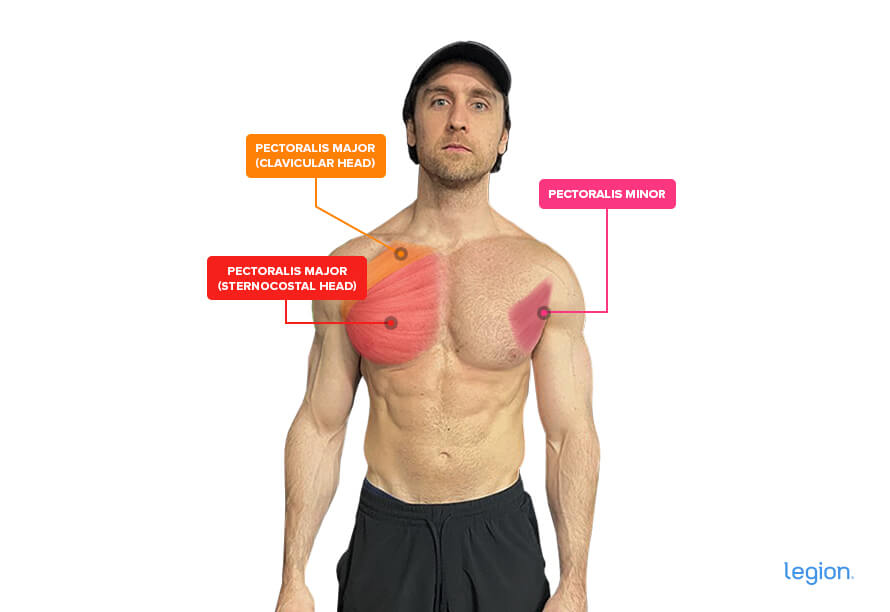
As you can see, the pectoralis major has two sections or “heads:” the sternocostal head (“lower chest”) and clavicular head (“upper chest”). Thus, to develop full, proportional pecs, your chest workouts at home must include exercises that emphasize both sections.
The other noteworthy part of the pecs is the pectoralis minor. The “pec minor” lies underneath the pectoralis major and pulls the shoulder blade forward and toward the middle of your chest.
Many of the same exercises that effectively train the pec major also involve the pec minor, so it’s not necessary to use specific at-home chest exercises for the pec minor (and even if you did, it’d be hard to see whether or not your pec minor was growing).
The Simple Science of Effective At-Home Chest Workouts
Creating an at-home chest workout is just like putting together any other chest workout, but with more constraints.
You probably won’t have the hardware (e.g., a bench and a barbell) that most chest workout routines call for. Instead, you might only have your bodyweight, some resistance bands, and perhaps a few dumbbells or kettlebells.
Bare-bones setups like this make it challenging to progressively increase the weights you lift. This is significant because lifting heavier weights over time (known as progressive overload) is the primary driver of muscle and strength gain.
[Read More: Is Getting Stronger Really the Best Way to Gain Muscle?]
So, how should you progress in your at-home chest workouts? You have several options:
1. Do more reps or sets.
High-rep sets (more than 10 reps) tend not to be much fun, but they can be just as effective for building and maintaining muscle as low-rep sets if you push close to failure.
However, this only holds true for sets up to about 20 or 30 reps—doing 100 reps to failure isn’t as beneficial for muscle growth as doing 20 reps to failure.
Doing more sets can also be an effective strategy for goosing strength and muscle gain—even with bodyweight exercises—but it also quickly hits a point of diminishing returns.
Doing more than 12-to-15 sets per muscle group per workout or more than 15-to-20 sets per muscle group per week usually doesn’t lead to additional gains and raises the risk of repetitive strain injuries (RSI).
2. Use more challenging exercise variations.
For example, feet-elevated push-ups instead of regular push-ups or band push-ups instead of feet-elevated push-ups.
This can buy you a few more weeks or maybe even months of progress, but you’ll eventually run into the same problems—your workouts won’t be difficult enough to keep gaining muscle and strength.
3. Use bands or dumbbells.
Using bands or dumbbells can make your workouts significantly more challenging, enjoyable, and productive—enough to continue gaining muscle and strength even without a “real” home gym.
How effective can chest workouts at home really be, though?
If you’re a beginner weightlifter (less than a year of weightlifting experience), you can effectively gain chest muscle and strength with at-home chest workouts.
You won’t progress as quickly as you would if you were following a barbell-based training plan, but you’ll get noticeable results.
And if you’re more advanced, you can probably maintain most of your chest size and strength with pec workouts at home for at least a month or so. If you have bands, you can probably extend this by another month (or possibly more).
And if you have a heavy enough set of dumbbells, you can maintain your physique more or less indefinitely (although you’ll likely lose some strength).
I’m a prime example of how effective chest workouts at home can be. I used the same kinds of at-home chest workouts you’re going to learn in this article to easily maintain my muscle mass (while losing body fat) when my gym was closed for several months in early 2020.
Here’s a pic of me in late 2019 before the Covid lockdowns (left) and one of me after several months of chest workouts at home:
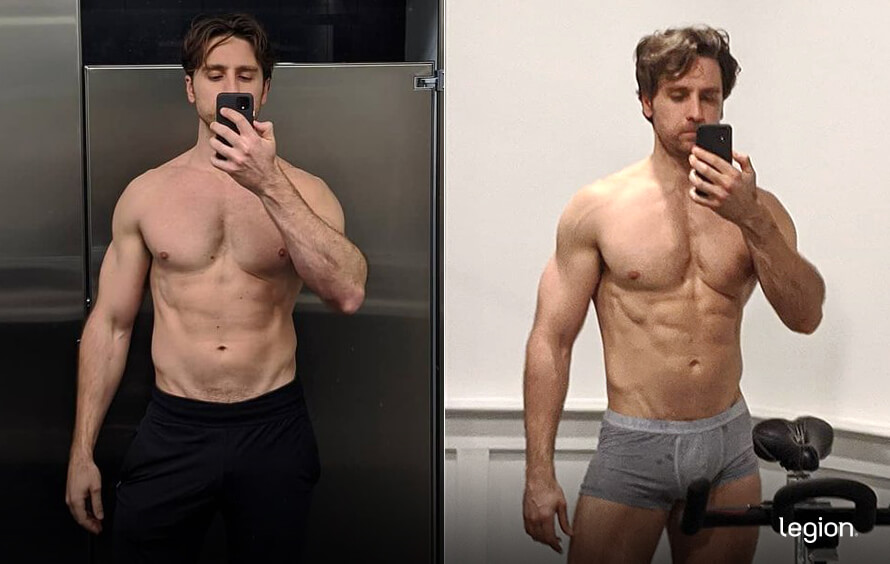
Not too different, I’m sure you’ll agree.
Alright, with that nerdy knowhow out of the way, let’s get to the at-home chest workouts.
The Legion At-Home Chest Workouts
These at-home chest workouts are ideal if you have no equipment whatsoever. Just choose which suits your experience level best and follow the routine as it’s laid out.
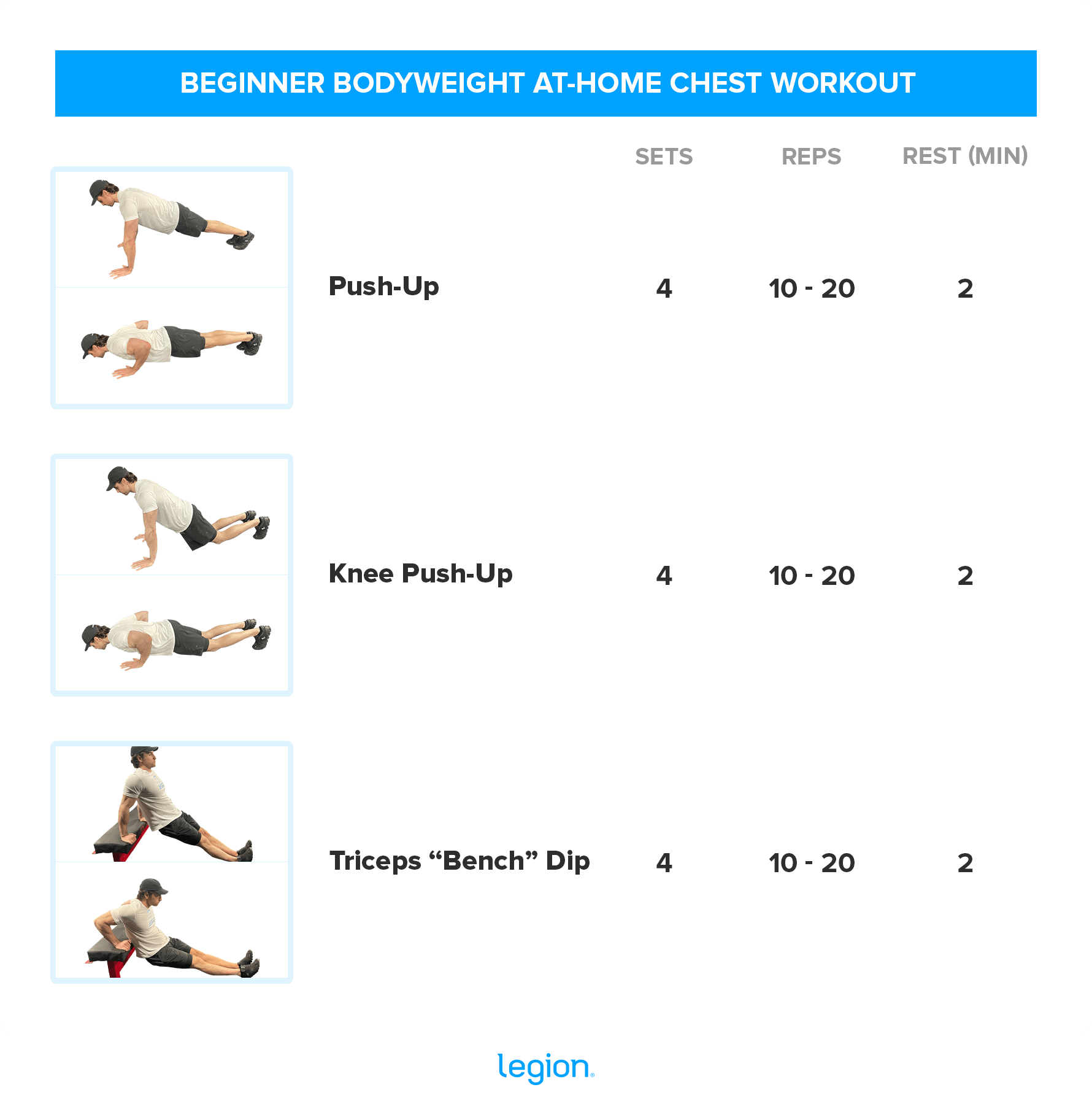
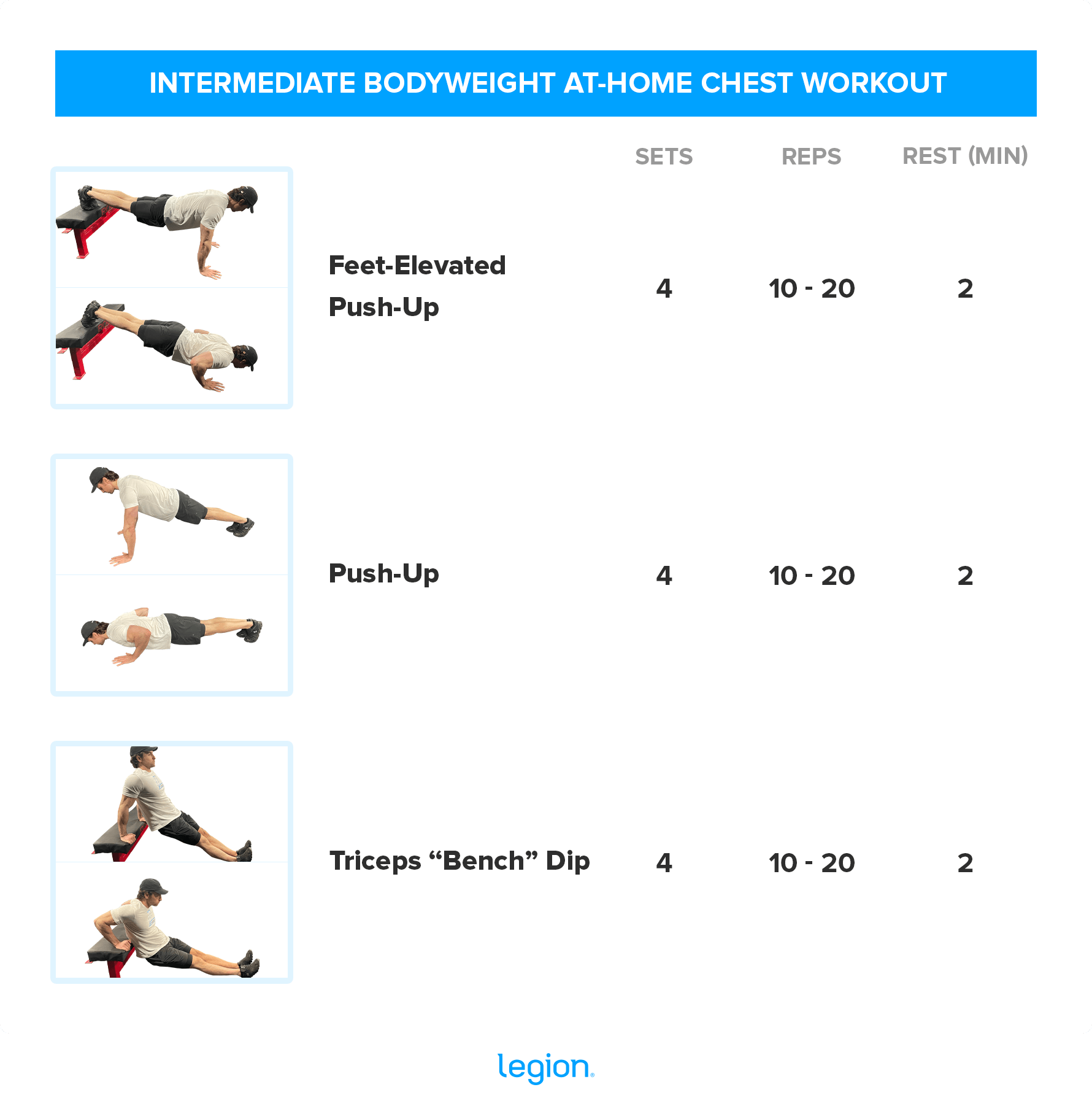
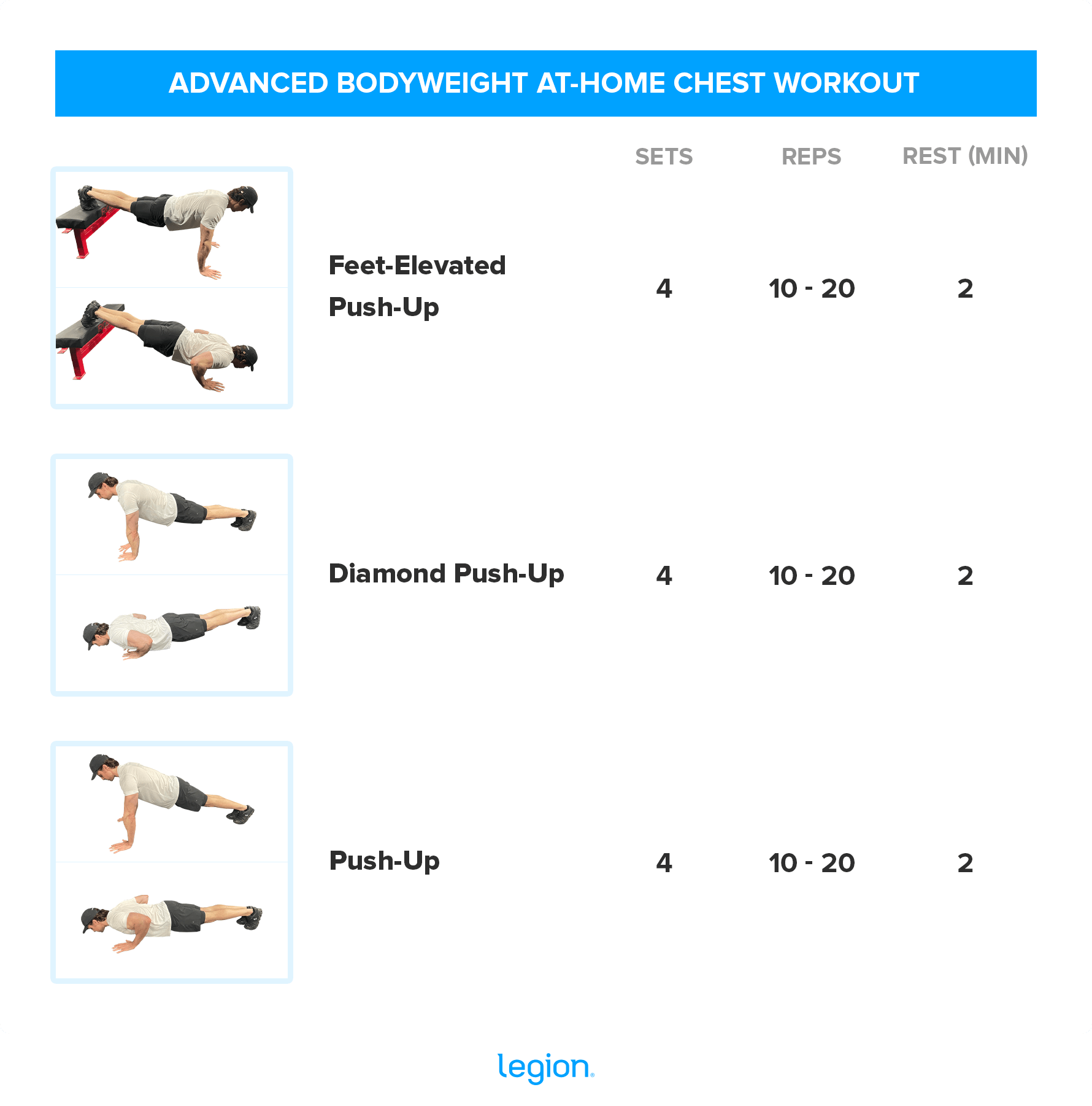
The Legion Band At-Home Chest Workouts
Getting your mitts on a few resistance bands can make a big difference to your pec workouts at home. In fact, research shows that for most people, training with bands is enough to help you maintain all your muscle and strength.
Here are three resistance-band chest workouts for every fitness level:
The Legion Dumbbell/Kettlebell At-Home Chest Workouts
These at-home chest workouts with dumbbells or kettlebells are excellent for gaining chest size and strength:
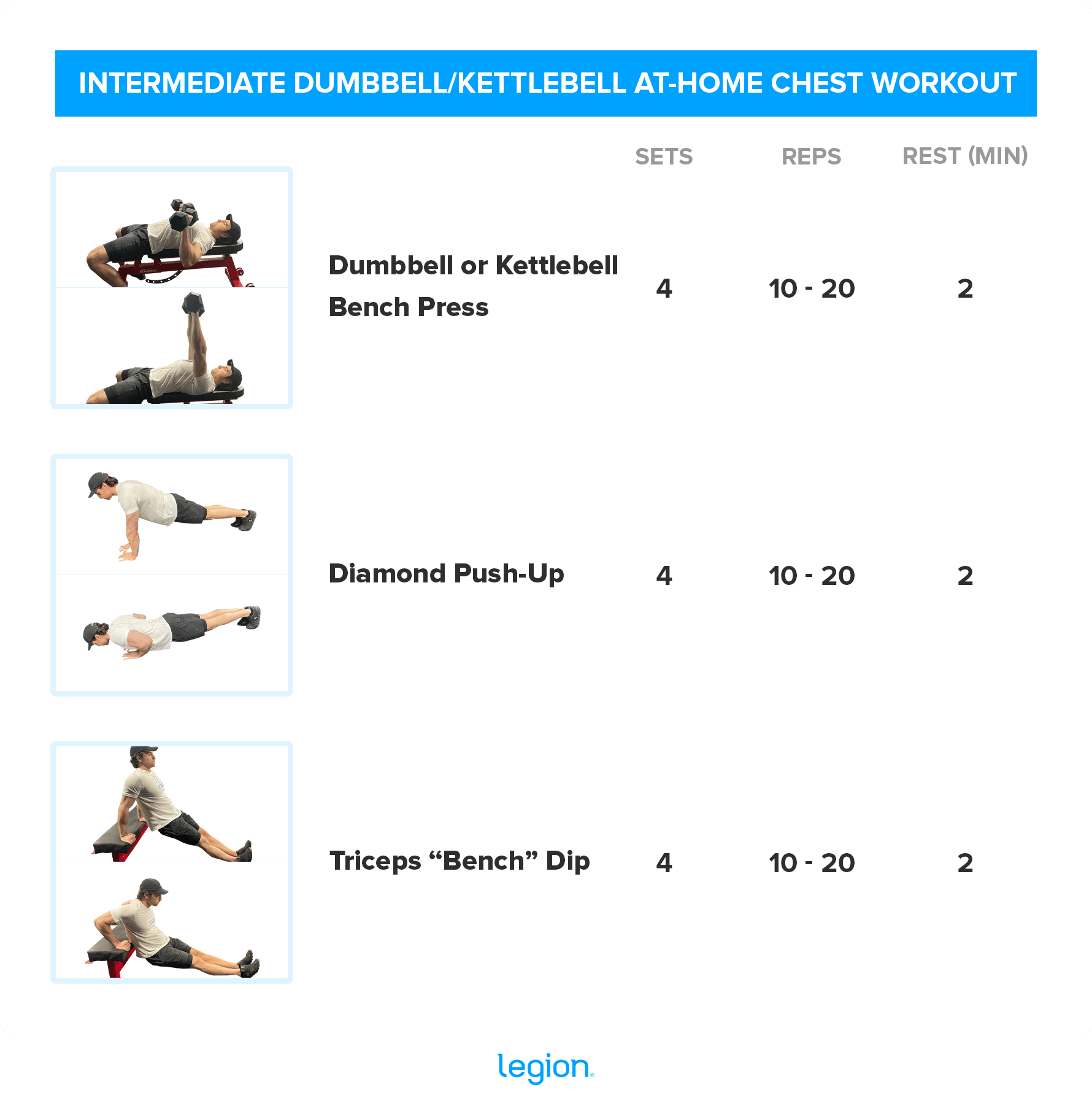
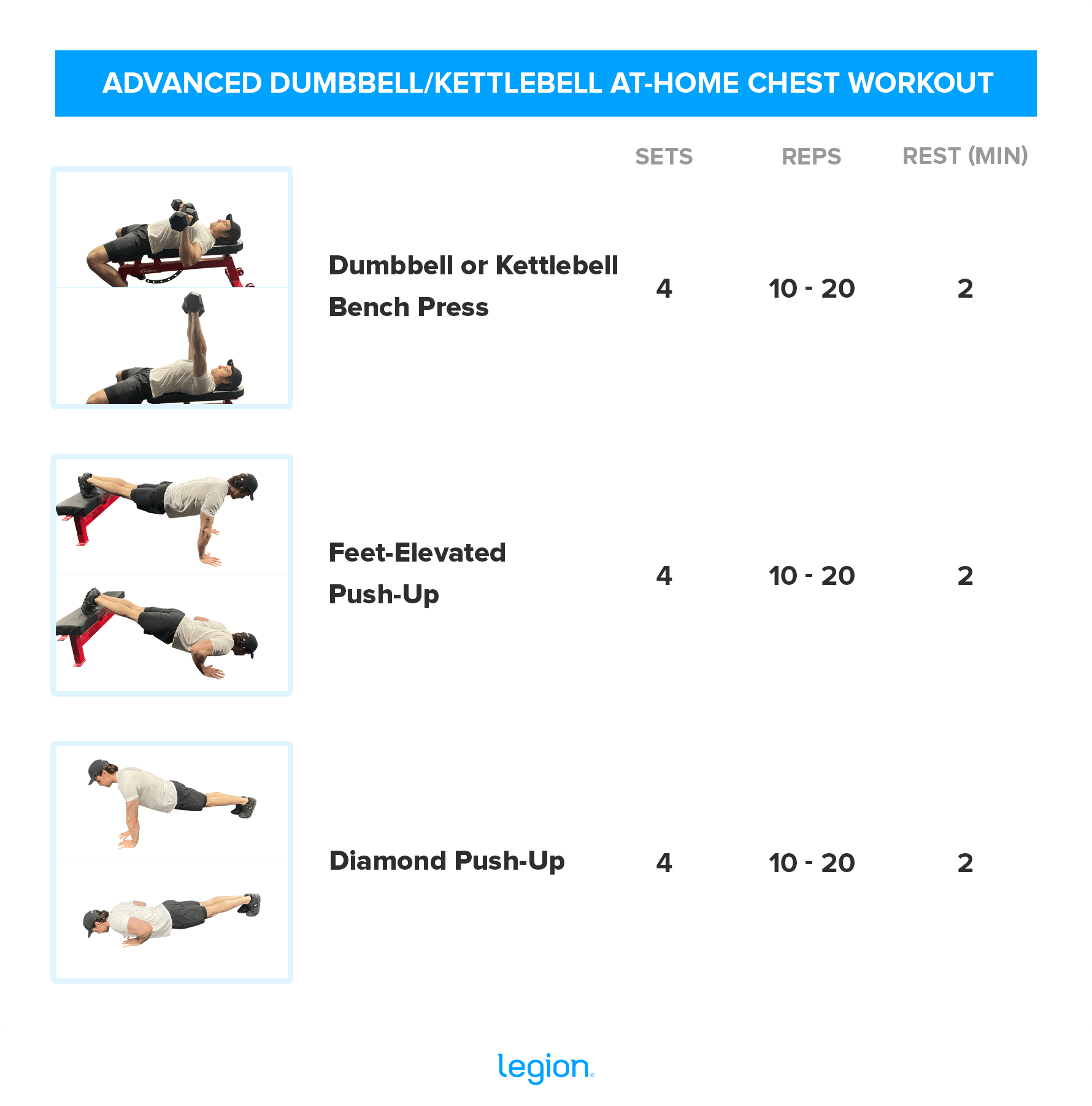
3 Tips for Better At-Home Chest Workouts
1. Do two chest workouts per week.
For best results, I recommend doing at least two chest workouts per week separated by at least one day where you don’t train your chest (a rest day or lower body workout day).
For example, you could do your at-home chest workout on Monday, train other muscle groups, do cardio, or rest on Tuesday and Wednesday, then repeat your chest workout again on Thursday.
Here’s an example of what this would look like throughout the week if you were also doing dedicated back and lower-body workouts:

And here’s what this would look like if you only wanted to train three times per week:

2. End every set one or two reps short of absolute failure.
You don’t need to take every set to the point of absolute muscle failure, but you do have to come close.
You’ll learn to recognize this point the more you work out—it’s when you strain for a rep and feel pretty sure you won’t get the next one.
3. Rest a minute or two between sets.
You should rest long enough for your breathing and heart rate to settle down, but not so long that you lose your focus, which is usually around two minutes for at-home chest exercises.
The Best Equipment for At-Home Chest Workouts
The best way to maintain or gain strength and muscle with at-home chest workouts is to invest in a few pieces of equipment that allow you to more effectively implement progressive overload.
Here are the best ones:
- Push-up Handles: Push-up handles extend a push-up’s range of motion, which likely benefits muscle growth. They also take the strain off your wrists, which is helpful if you plan on doing at-home chest workouts for more than a few weeks (all those push-ups can beat up your wrists).
- Resistance Bands: Resistance bands add resistance to all kinds of exercises, including push-ups and chest presses.
- Dumbbells or Kettlebells: Picking up a set of adjustable dumbbells or a few kettlebells is the best way to make your at-home chest workouts even more productive.
- Adjustable Bench: Having an adjustable bench allows you to do more dumbbell and kettlebell exercises through a longer range of motion and more safely.
- Dip Stand: A dip stand is handy for doing a number of bodyweight exercises, especially dips. What’s more, if you also get a dip belt, you can incrementally increase the weight you lift by hanging weight from your waist.
The post The Best At-Home Chest Workouts (with Bodyweight, Dumbbells, or Bands!) appeared first on Legion Athletics.
https://ift.tt/HfTlsry May 21, 2024 at 06:00PM Legion Athletics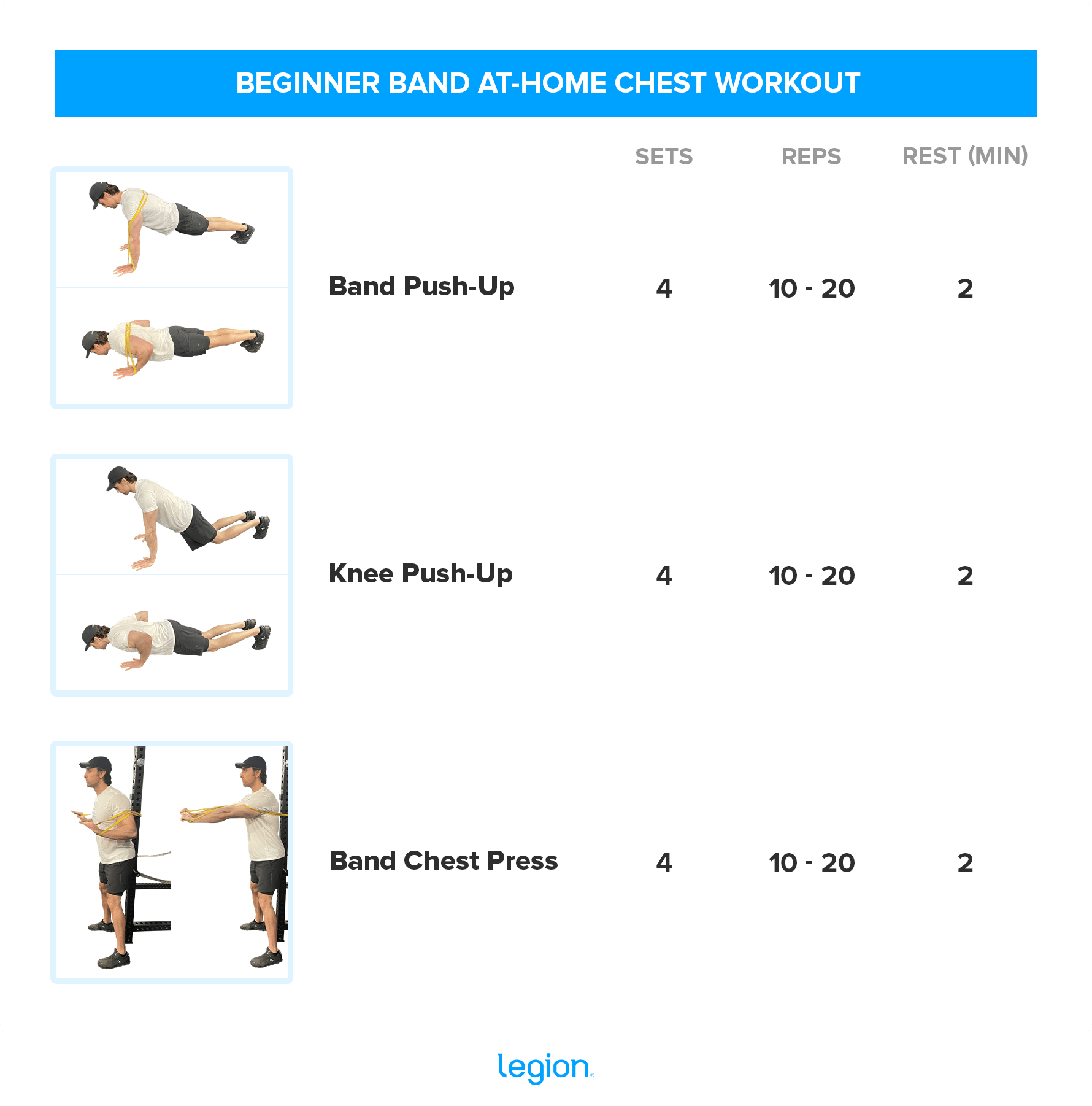
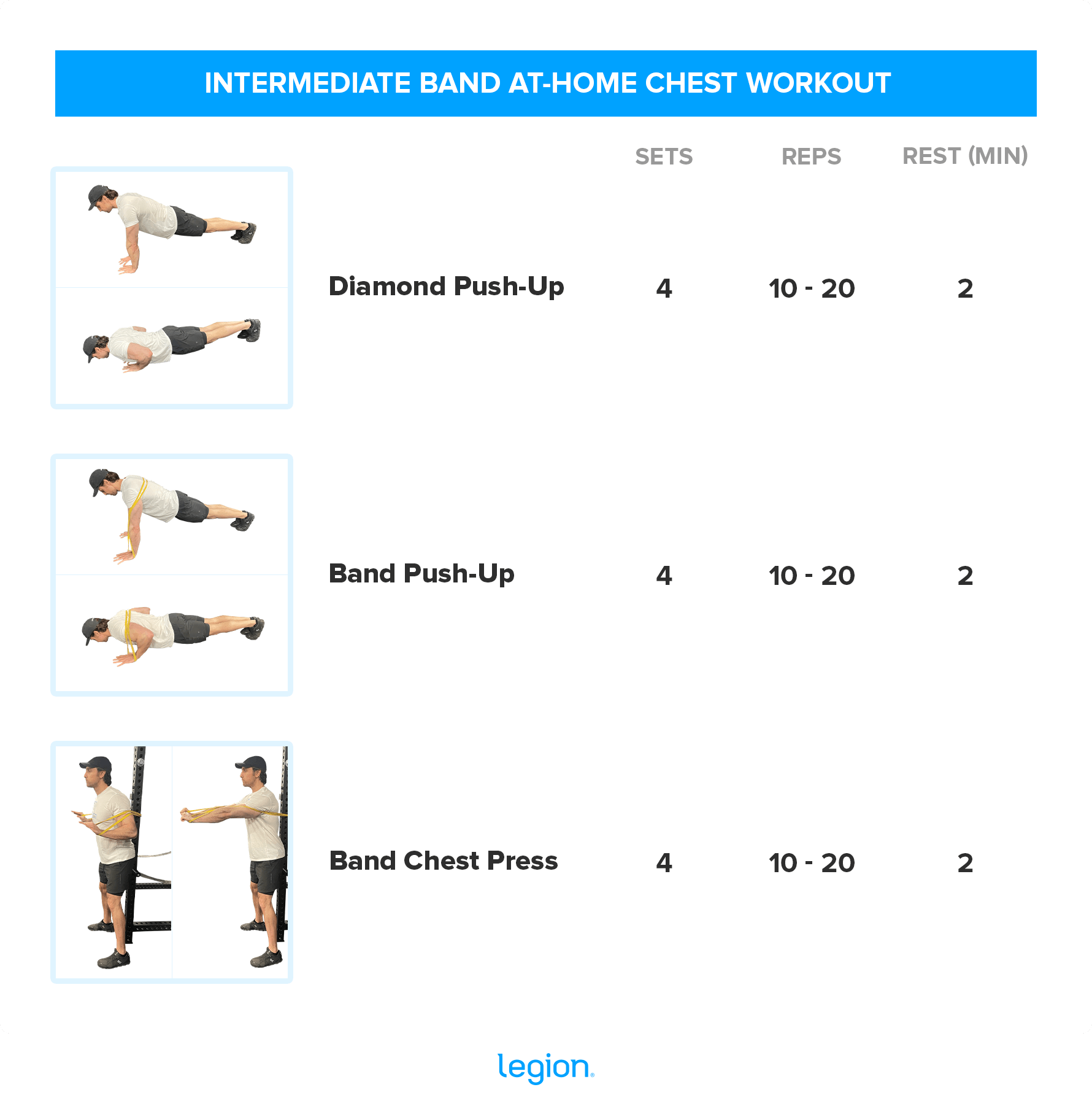
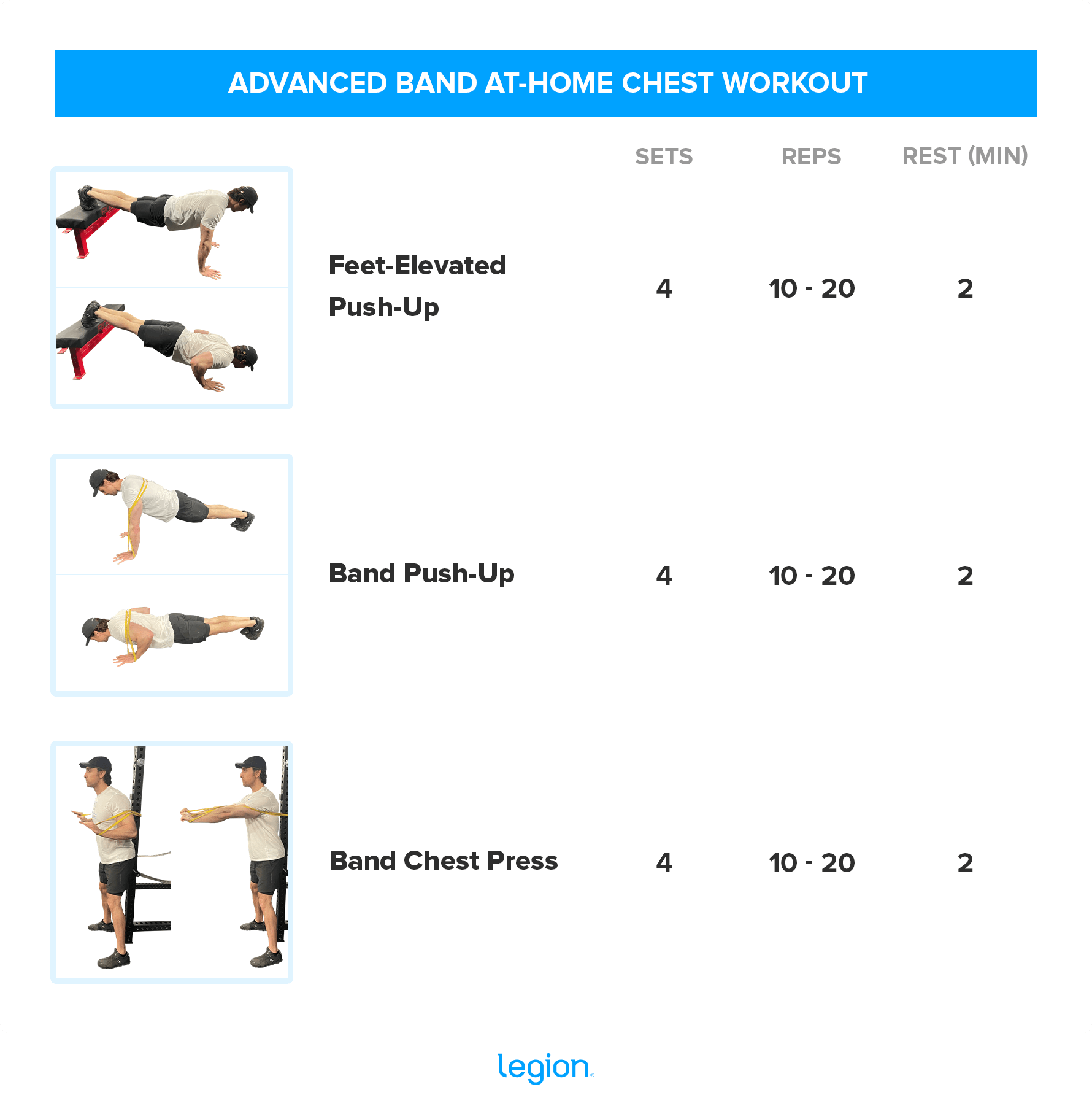
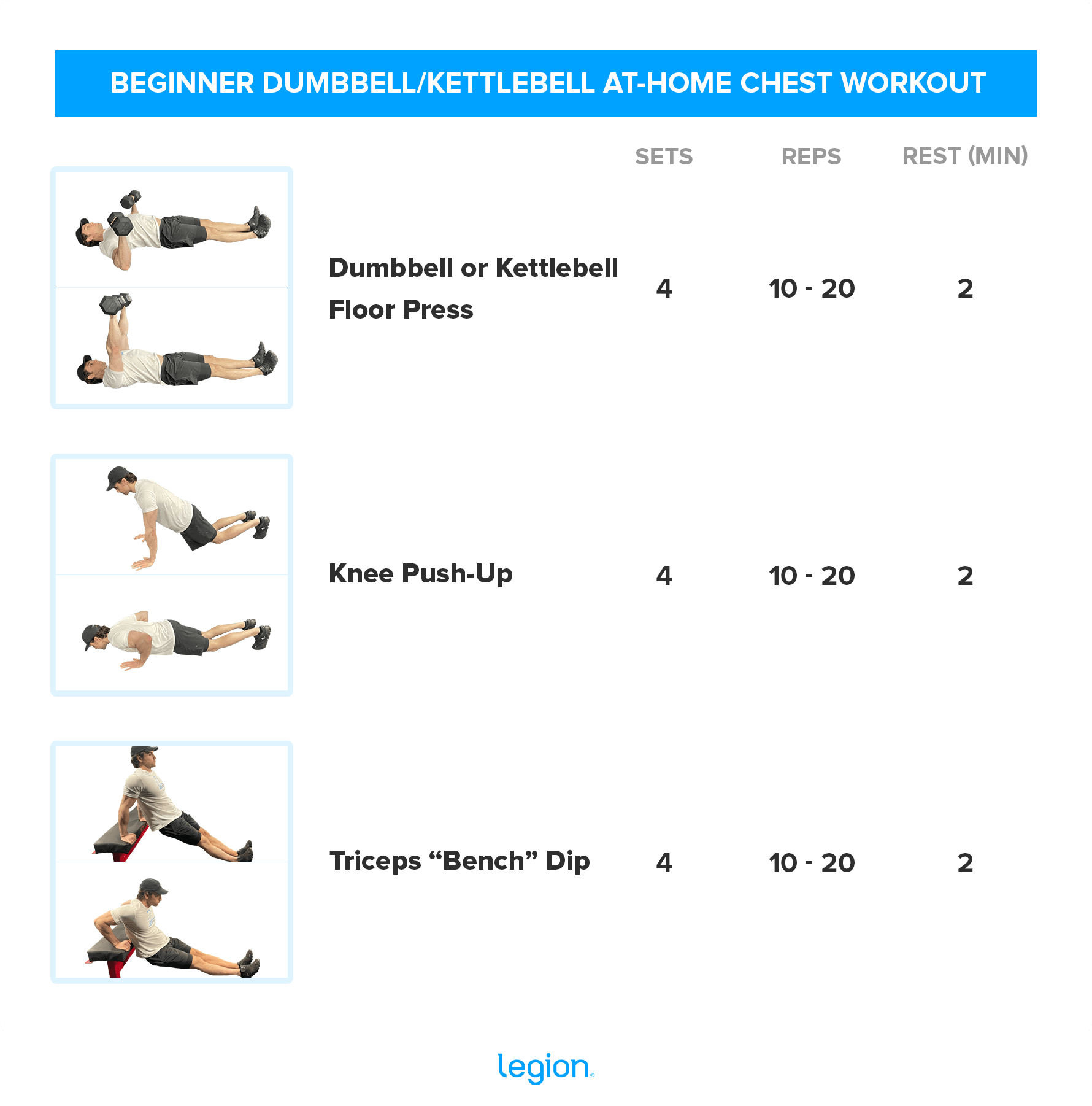
Comments
Post a Comment